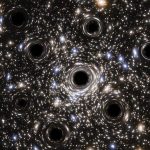The James Webb Space Telescope spotted dimethyl sulfide—which is only unique to life on Earth—on a far-away exoplanet.
Key takeaways
- Researchers detected dimethyl sulfide (DMS), a chemical linked to life, in the atmosphere of exoplanet K2-18 b using the James Webb Space Telescope (JWST).
- This detection is not yet confirmed, requiring further data to verify if DMS is truly present on K2-18 b.
- K2-18 b, a Hycean world with a temperate ocean and hydrogen-rich atmosphere, is in the habitable zone of its star, making it a prime candidate for supporting life.
- The JWST’s powerful observational capabilities have significantly improved our ability to detect chemical markers in exoplanetary atmospheres.
- Confirmation of DMS and understanding its implications will take additional observations, with researchers cautioning against premature conclusions about extraterrestrial life.
We’ve had a lot of extraterrestrial-adjacent news this week. From there’s-no-way-these-are-real “aliens” in Mexico to a NASA conference on UFOs (or UAP, as they’re now being called), it’s been a week full of speculation about life on other worlds.
However, this piece of news differs from the rest in a potentially extremely exciting way. Researchers recently revealed, in a new work accepted for publication in The Astrophysical Journal, that they detected a highly unusual chemical signature in the atmosphere of a distant exoplanet dubbed K2-18 b using the James Webb Space Telescope.
The chemical is known as dimethyl sulfide, or DMS. On Earth, it is only created by living beings.
Now, before we get ahead of ourselves, this is a preliminary detection. While JWST is an extremely powerful telescope capable of detecting very clear traces of molecules such as carbon dioxide and methane, the detection of DMS is still considered “possible.” Additional data collecting will be required to confirm if the chemical is indeed present in the environment.
We had a similar “hold-the-phone” moment a few years ago when physicists discovered phosphene in the atmosphere of Venus. The Venus potential life signature was eventually discounted, although it was obviously worth double-checking.

As is this detection of DMS—especially considering that, if we were to find signs of life on other worlds, K2-18 b is exactly the kind of world we’d expect to find it on.
Researchers were interested in K2-18 b, a sub-Neptunian planet about 8.6 times the mass of Earth, after identifying water vapor in its atmosphere. We can’t view K2-18 b well enough to capture a visual photo of it, so researchers define it using mass estimations and chemical markers.
Our current working theory for K2-18 b classifies it as a Hycean world, which is totally covered by a temperate ocean and surrounded by a hydrogen-rich atmosphere. It circles a rather cold star and is perfectly located in its system’s habitable zone. All of these are relatively high points in the “helpful” column for promoting life.
It’s a promising planet with an exciting possible discovery, but even the project’s researchers are warning against getting ahead of themselves. The universe is large and varied. When searching for extraterrestrial life, all other viable answers must be ruled out before you can exclaim eureka. “Aliens” is not the first option researchers consider—it may be the most thrilling to the majority of people, but it is a last resort.
Even if it isn’t extraterrestrial life, it’s a fantastic demonstration of JWST’s observational capabilities.
“This result was only possible because of the extended wavelength range and unprecedented sensitivity of Webb, which enabled robust detection of spectral features with just two transits,” said Nikku Madhusudhan, the paper’s principal author, in a NASA press release.
The term “transits” refers to when a planet passes in front of a star. When a planet stands between us and a star, part of the light emitted by the star is filtered via the planet’s atmosphere before reaching us. We can learn about the chemical makeup of exoplanets by observing how starlight varies.
“For comparison,” Madhusudhan added, “one transit observation with Webb provided comparable precision to eight observations with Hubble conducted over a few years and in a relatively narrow wavelength range.”
Whether or when extraterrestrial species exist, we are getting good enough at looking into planetary atmospheres to detect flags. Many of those flags will most likely be false, but having the ability to view flags at all was utterly out of reach not long ago.
“Our ultimate goal is the identification of life on a habitable exoplanet, which would transform our understanding of our place in the universe,” Madhusudhan reported in a news release. “Our findings are a promising step towards a deeper understanding of Hycean worlds in this quest.”
And who knows. Perhaps the mission is complete, and this isn’t a false flag after all. We will have to wait a year for the follow-up observation and see for ourselves.

